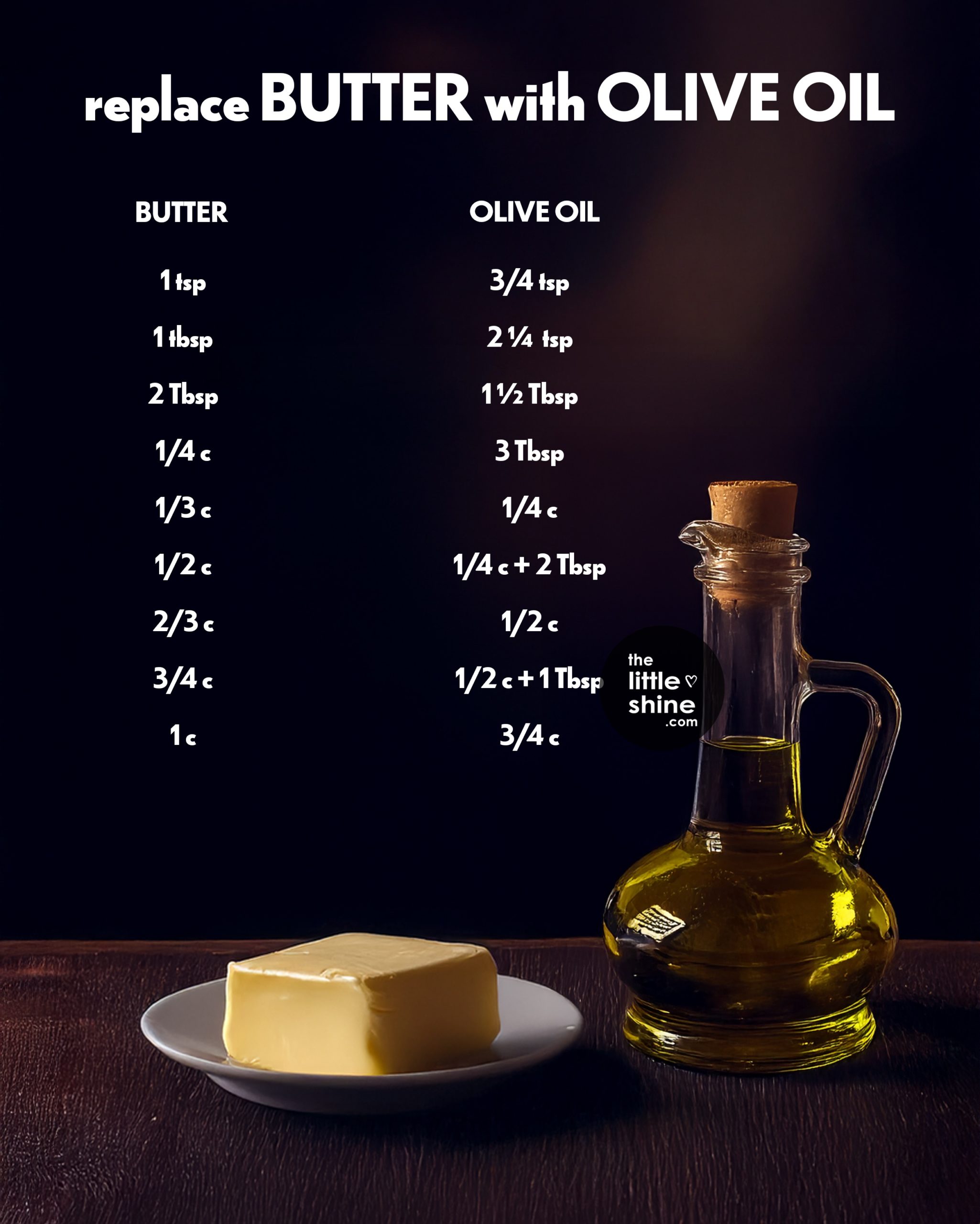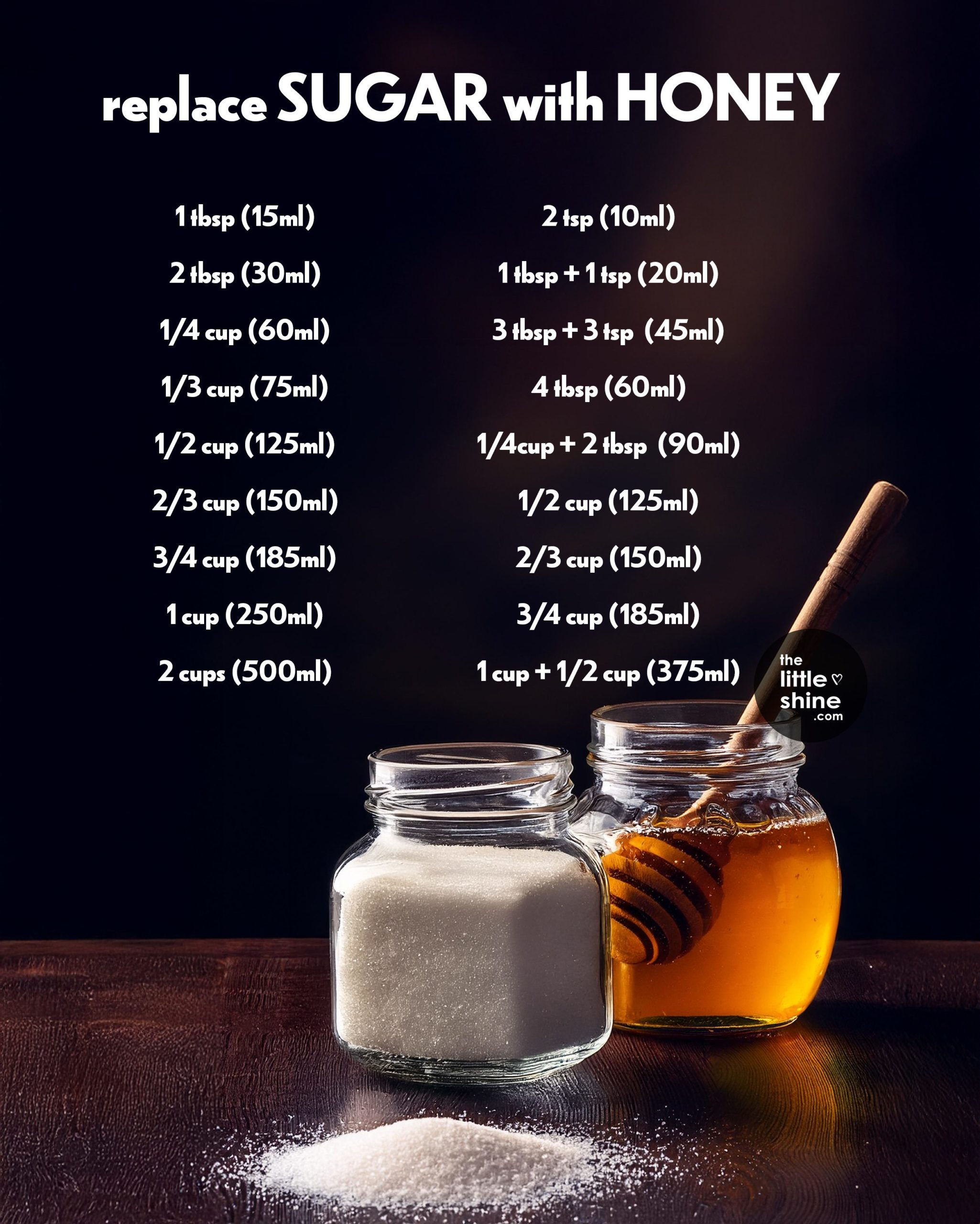I’m sure you’ve been in situations wherein you’ve decided to bake something and turns out you’re missing one of the main ingredients, say maybe the butter? Or maybe you just want to swap the sugar for honey, as a healthier alternative but cannot seem to figure out the right proportions of doing so.
Well, let us discuss baking conversions for essential substitute ingredients like butter to oil and sugar to honey in various forms of measurements like teaspoons, tablespoons, cups, millilitre, grams etc.

Baking Substitutes Conversions and Proportions
Butter to Oil Conversion for Baking
If a recipe calls for softened butter or melted butter, then using any neutral oil (like vegetable oil, sunflower oil, olive oil etc., can make for the simplest and easy substitute for butter.
Here’s the conversion ratio for butter to oil substitution:
**Teaspoons, Tablespoons and Cups Conversion
1 teaspoon butter = ¾ teaspoon oil
1 tablespoon butter = 2¼ teaspoon oil
2 tablespoon butter = 1½ tablespoon oil
¼ cup butter (½ stick) = 3 tablespoons oil
½ cup butter (1 stick) = ½ cup + 2 tablespoons oil
2/3 cup butter = ½ cup oil
¾ cup butter = ½ cup + 1 tablespoon oil
1 cup (2 sticks) butter = ¾ cup oil
2 cups (4 sticks) butter = 1½ cups oil
** Millilitre to Millilitre (ml to ml) Conversion
100 ml butter = 75 ml oil
200 ml butter = 150 ml oil
300 ml butter = 225 ml oil
400 ml butter = 300 ml oil
500 ml butter = 375 ml oil
600 ml butter = 450 ml oil
700 ml butter = 525 ml oil
800 ml butter = 600 ml oil
900 ml butter = 675 ml oil
1000 ml butter = 750 ml oil
** Gram to Millilitre (gram to ml) Conversion
100 grams butter = 78 ml oil
200 grams butter = 156 ml oil
300 grams butter = 234 ml oil
400 grams butter = 312 ml oil
500 grams butter = 390 ml oil
600 grams butter = 468 ml oil
700 grams butter = 546 ml oil
800 grams butter = 624 ml oil
900 grams butter = 702 ml oil
1000 grams butter = 780 ml oil

Sugar to Honey Conversion for Baking
Often people use honey in baking recipes instead of sugar, because it is a healthier alternative. Well, while you do so, keep in mind these tips –
- Add in ¼ to ½ teaspoon of baking soda, for every cup of honey added. This will help balance the acidity of the baked item. Do this only if your recipe doesn’t already call for baking soda.
- Make sure to reduce the temperature of your oven by around 25 degrees, as honey browns faster (because of its high sugar content).
- 1 cup of sugar can be substituted with either ½ to ¾ cup of honey on an average.
- Honey is liquid in consistency as compared to sugar and therefore, you can reduce the other liquids in your recipe by ¼ cup (for every cup of honey added).
Here’s the conversion ratio for sugar to honey substitution:
**Teaspoons, Tablespoons and Cups Conversion
1 tablespoon sugar = 2 teaspoons honey
2 tablespoons sugar = 1 tablespoon + 1 teaspoon honey
¼ cup sugar = 2 tablespoons + 3 teaspoons honey
(+1/8 tsp baking soda)
1/3 cup sugar = 4 tablespoons honey
(+1/4 tsp baking soda)
½ cup sugar = ¼ cup + 2 tablespoons honey
(+1/4 tsp baking soda – reduce liquid by 2 tsp)
2/3 cup sugar = ½ cup honey
(+1/4 tsp baking soda – reduce liquid by 5 tsp)
¾ cup sugar = 2/3 cup honey
(+1/2 tsp baking soda – reduce liquid by 2 tbsp)
1 cup sugar = ¾ cup honey
(+1/2 tsp baking soda – reduce liquid by 2 + ½ tbsp)
2 cups sugar = 1 + ½ cup honey
(+1/2 tsp baking soda – reduce liquid by 5 tbsp)
** Millilitre to Millilitre (ml to ml) Conversion
15 ml sugar = 10 ml honey
30 ml sugar = 20 ml honey
60 ml sugar = 45 ml honey
(+1/8 tsp baking soda – reduce liquid by 25 ml)
75 ml sugar = 60 ml honey
(+1/4 tsp baking soda)
125 ml sugar = 90 ml honey
(+1/4 tsp baking soda – reduce liquid by 10 ml)
150 ml sugar = 125 ml honey
(+1/4 tsp baking soda – reduce liquid by 25 ml)
185 ml sugar = 150 ml honey
(+1/2 tsp baking soda – reduce liquid by 30 ml)
250 ml sugar = 185 ml honey
(+1/2 tsp baking soda – reduce liquid by 37 ml)
500 ml sugar = 375 ml honey
(+1/2 tsp baking soda – reduce liquid by 70 ml)
